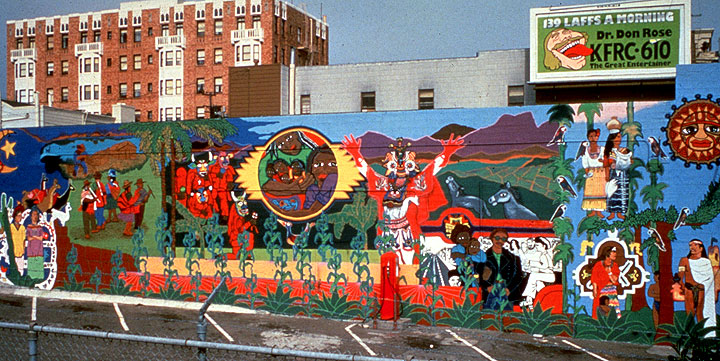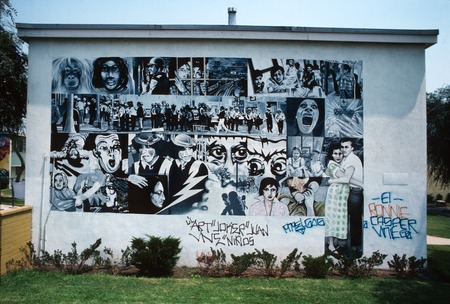
Gronk, and Herron Willie. Moratorium: The Black and White Mural. 1973.
"During the start of ASCO, everthing we did was considered to be not Chicano art. We were not the Chicano artists that people were looking for. People were looking for artists that were creating pre-Columbian motifs. People were looking for things that were somewhat folkloric. People were not interested in artists that were responding to urban life, the kinds of concerns of the late 20th century, the kinds of things that related to global culture."
- Harry Gamboa Jr., Chicano artist, "The ASCO Interviews", 2014.
"I think the only time that anything happens is when there’s a hate crime or something. There was a mural that we did that was all done by our girls mural arts program and they did a lot of women in the mural, which was in the Mission District around 22nd and Bartlett right behind the Mission Market. They did this mural there and often it was graffitied and the women’s faces were scratched out or painted over."
-Susan Cervantes, founder and director of the Precita Eyes Muralists, Telephone interview, 2021
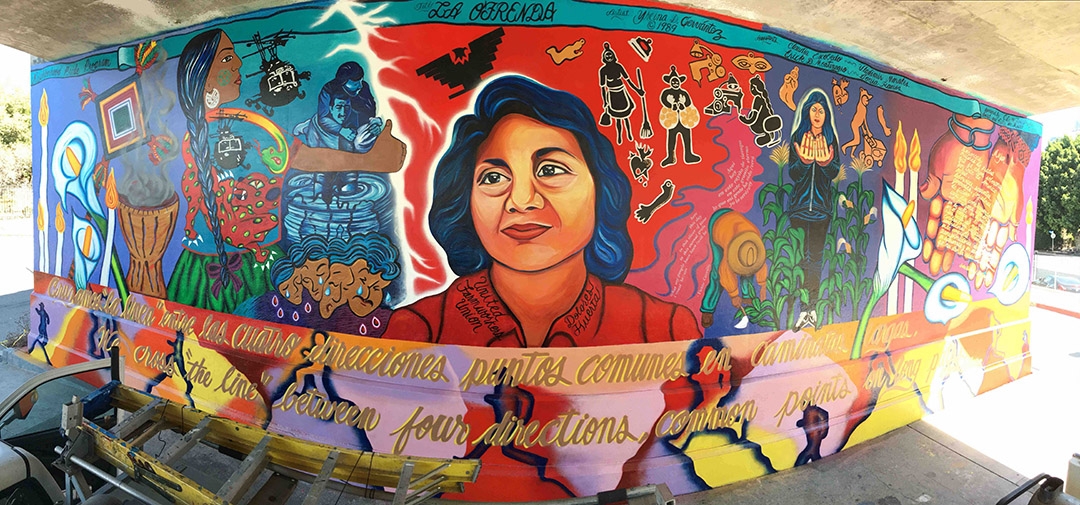
Cervantez, Yriena. La Ofrenda.1989.
"If we think about the role of art in the Chicano movement. The plan of Aztlan has a clear section where they reference the importance of art in the Chicano movement, but the Plan of Aztlan is also very patriarchal. If you talk to any Chicana feminist who came through the Chicano movement at the time, they’ll tell you stories of literally being put on trial for not representing the correct type of Chicana identitiy. Even though the Plan of Aztlan makes a reference to art I’m sure there were boundaries of what is permissible Chicano art and there was probably policing of what is the correct way to engage with Chicano issues, even what is a Chicano issue. Would something be labeled a white feminist issue even if it was a Chicana creating the art."
- Katynka Martinez, Chicano Studies professor at San Francisco State Univeristy, Videoconference interview, 2021.
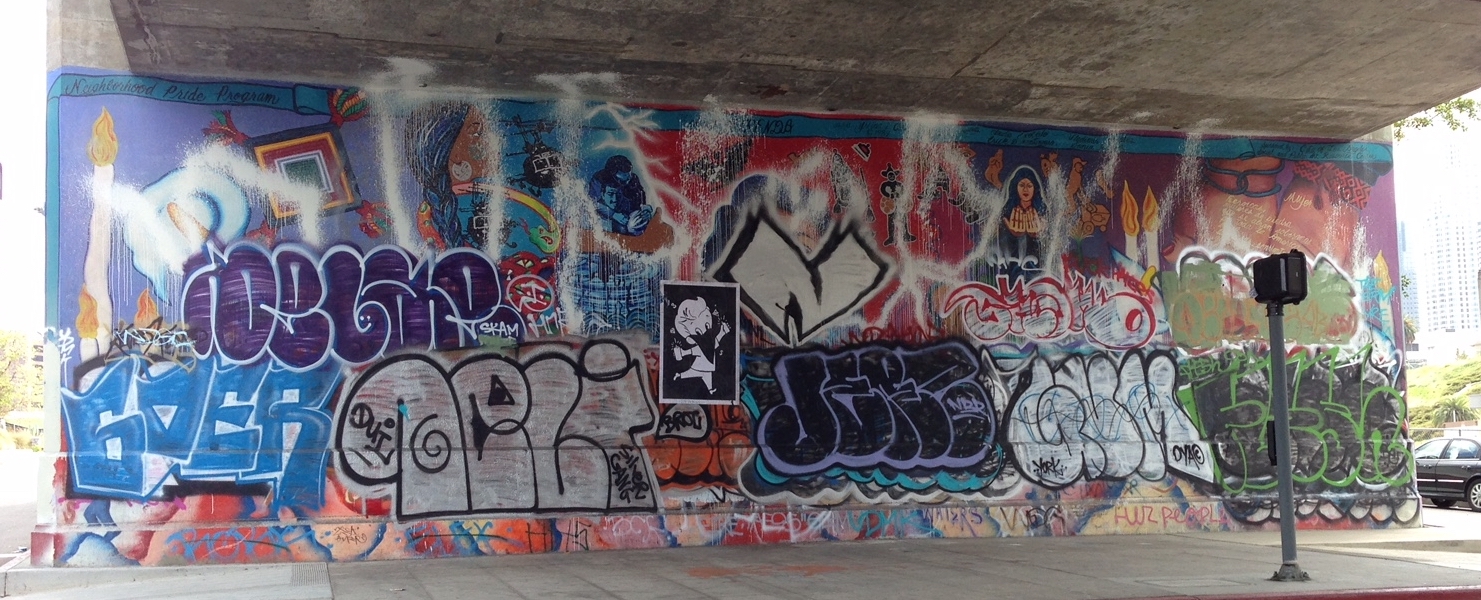
Cervantez, Yriena. La Ofrenda.1989.
Often during the movement, female artists and Chicana needs were excluded and their artwork was vandalized. Chicana muralists such as Yierna Cervantez defied the male-dominated expectations for acceptable Chicano art by creating artwork to empower Chicana feminists. Prejudice against Chicana artists has continued beyond the time of the movement.
"Police, the other men, sometimes people wrote terrible things about us saying that we were making these messes in the streets of LA. There was resistance everywhere, but there was also this amazing outpouring of love as people started to see what we were doing. People were writing: look at all those kids working together and how did she get them to do that. It was really in a sense easy because what they wanted was to do something powerful and good for their community."
- Judy Baca, Chicana mural artists, Videoconference interview, 2021.
"The fact was, although most people will say "oh you grew up in poverty and you grew up in East Los Angeles", that didn't mean you lived in a vaccum, somewhere that was not connected to the rest of the world."
- Glugio "Gronk" Nicandro, Chicano artist, The ASCO Interviews, 2014.
There was a standard that Chicano art was inclusive to "Chicano issues", however, artists rejected limitations by creating artwork that was globally conscious.
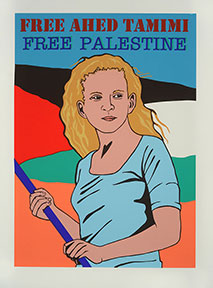
Fuentes, Juan. Free Ahed Tamimi.
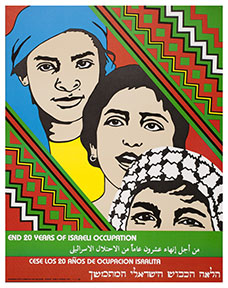
Fuentes, Juan. End 20 Years of Israeli Occupation, 1987.
"The only poster that I’ve gotten any flack for, where people are really upset, are the posters that I have done around Palestine. With my Palenstinian posters I have gotten where people have come really angry because they’ve seen the posters up, either in an exhibit or somewhere and then they don’t agree with it. I’ve had that issue here, in the Bay Area, and when I was doing my artist's residency in North Carolina I had the same issue. There, because I had posters up during my residency around Palenstine. Some people came in and complained. They were really enraged that I would have something like that up. But I did and I stuck to my guns and I was able to leave my stuff up. I said I’m not gonna move them that’s for sure. That's what I do."
- Juan Fuentes, Chicano artist, Telephone interview, 2021.
"That's basically what I've been doing -- being unapologetic about who I am both as undocumented, as a queer person, as a chubby man. I try to really be authentic in the artwork that I put out into the world."
- Julio Salgado, Chicanx artist, "How Julio Salgado Utilizes Art to Express Life As a Queer, Undocumented Man", 2019.
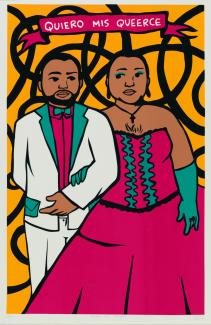
Salgado, Julio. Quiero Mis Queerce. 2014. screenprint on paper, Smithsonian American Art Museum.
Murals and posters became vehicles of defiance, even within the movement. It has created a tradition and a characteristic of Chicanx art to be confrontational when speaking to an issue and exploring ways to convey the artist's message through public art.
"If you're in the immigrant community, there could be homophobia, there could be transphobia. If you're in the queer community, you know, all they want to talk about is gay marriage. But, they don't want to talk about deportations. So when I'm making these images that speak to at least two communities, I have to do it because that's part of who I am."
- Julio Salgado, Chicanx artist, "How Julio Salgado Utilizes Art to Express Life As a Queer, Undocumented Man", 2019.

